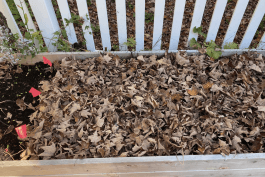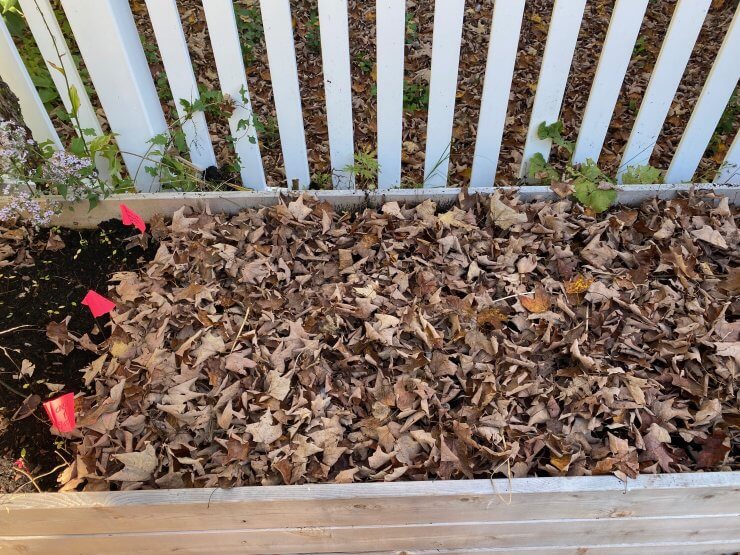
Garlic is my most-favorite herb of all time. I cook with it daily, and when I found out I had a nightshade sensitivity, I almost had a panic attack in the moments it took me to Google whether garlic was a nightshade. It’s not—crisis averted.
And that’s great, because I keep a fresh jar of Garlic Confit in my refrigerator at all times, and make a lemon garlic vinaigrette for dinner several times per week.
To support my garlic habit, one must grow their own garlic, mustn’t one? If you also feel the calling to plant your own little garlic patch, I’ll show you how.
How to Start a Garlic Patch in Your Garden
To grow garlic, you’ll use cloves right from the garlic you already have. While you can use the garlic you’ve gotten at the store, especially if it’s begun to start growing little green legs, we usually use what are called “seed cloves” which are cloves from bulbs of garlic that have been left in the ground a little longer, and we typically use the biggest cloves on those bulbs.
Before you get started, a few fun facts about some of the basic elements of planting garlic:
- Garden beds: Start with a clean, weed-free bed (garlic doesn’t like competition—who does?)
- Varietals: A rule of thumb is to plant hardneck garlic in Northern, cooler climates, and soft neck garlic in warmer climates.
- Season: You can plant garlic in early spring for a fall harvest, but garlic prefers overwintering and is best planted in the fall to be harvested in the middle of summer. If planting in the spring, you can vernalize your garlic, which means refrigerating it for four to eight weeks in a plastic bag with holes in it.
- Prep: Keep the peel on the clove when planting, it will protect it.
- Size: The bigger the clove, the bigger the bulb.
- Depth: In warmer climates (zone 8+), plant cloves 2″ deep. In cooler zones, plant 4″ deep to protect them from snow.
- Placement: Bugs don’t like garlic, so you can always plant them around the edges of your garden to help keep out pests.
- Companion plants: Lettuce, beets, broccoli, cabbage, kale, and tomatoes
- Plant foes: Beans, peas, asparagus, sage, parsley, onions, shallots, leeks, scallions, chives
- Rotation: Plant garlic no more than once every three years in the same location.

Steps for Planting Garlic
Once you know everything above, the planting itself is about as easy as planting anything else.
- Start with a bulb of garlic (don’t peel ahead of time), and remove cloves. Save the largest ones for planting.
- With the pointy side facing up, plant your cloves according to the depth guidelines above.
- Mulch with 4″ of compost, chopped leaves, or clipped grass.
- Water as needed if the ground gets dry, but don’t overwater. In the fall, the ground typically has a lot of moisture retained.
- In the spring after the last frost, you can remove the mulch or thin it out.
Weird Things You Might Come Across
- If you live in a cold climate, as the soil freezes and thaws in the winter, your garlic might get pushed toward the surface. That’s one of the reasons why you should plant them double as deep, and also a good reason to mulch deeply.
- If you see a plant growing that looks diseased, pull it and remove it from the garden. Disease can spread quickly with bulbs so best to remove them.
What are your tips and tricks for growing garlic? Let me know in the comments! And if you want to learn more about growing garlic, check out our Garlic Gardening Guide.


 Previous
Previous


I have vegetable garden boxes standing 36 inches above ground and I live in Idaho. Can I plant garlic in those boxes? They are about two feet deep.
Thanks for all your info. It is really helpful.
Absolutely, mine are about two feet. You’ll just want to plant 4” down instead of 2” to accommodate the cold weather and add a few inches of mulch on top of that (clear it off in the spring.)
Just planted my garlic yesterday. Can’t wait for summer
Same! Good luck!
Thank you so much. I live in Vancouver BC. Weather is not too extreme cold in
winter . House is facing east, garden soil
is very poor and hard. I love to try the hard head garlics with long standing
stamps. Thanks again for your help.
You’re so welcome! We have lots more info in our garlic collection as well! https://foodgardening.mequoda.com/toc/collections-glorious-garlic-from-garden-to-table/